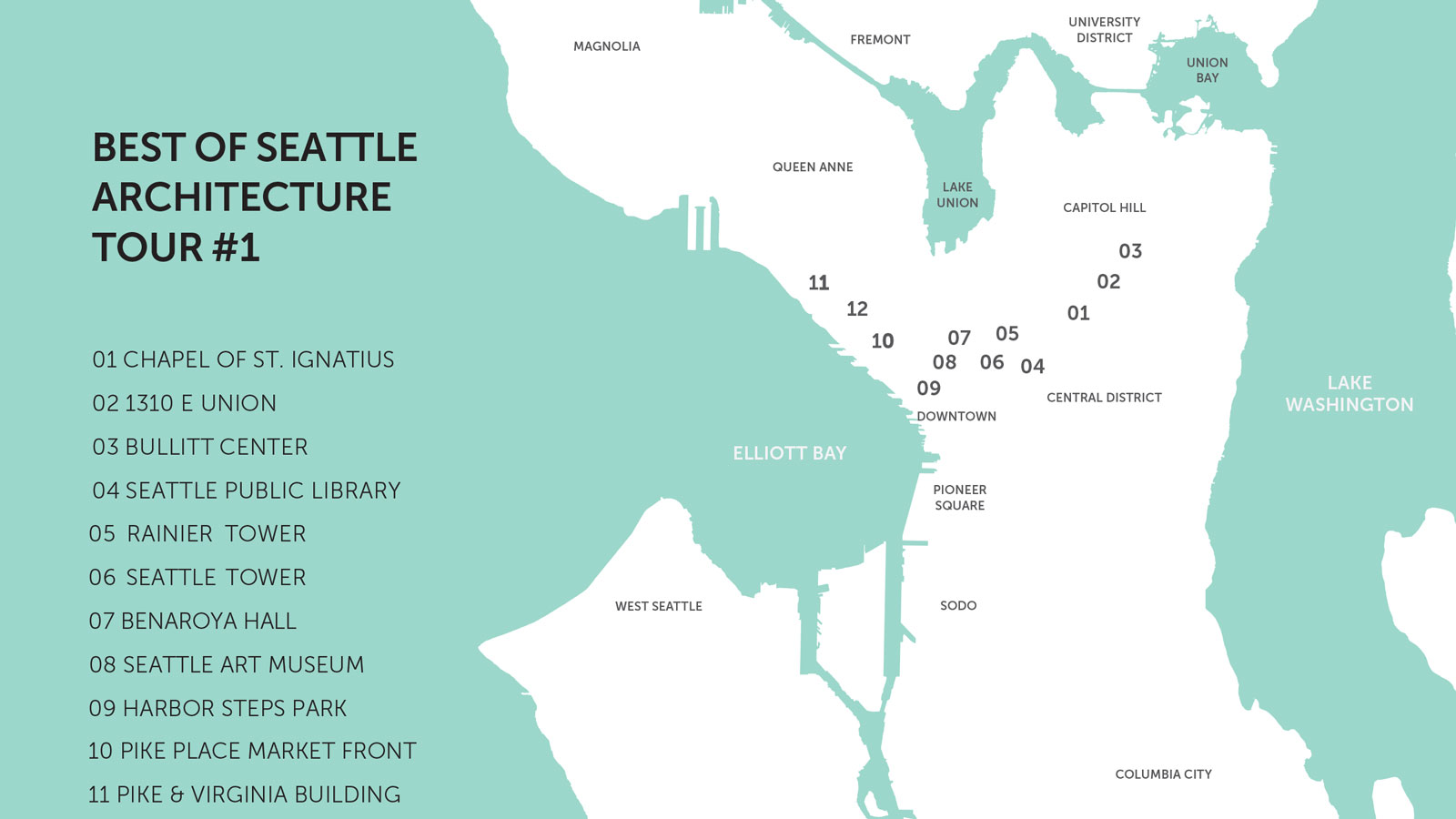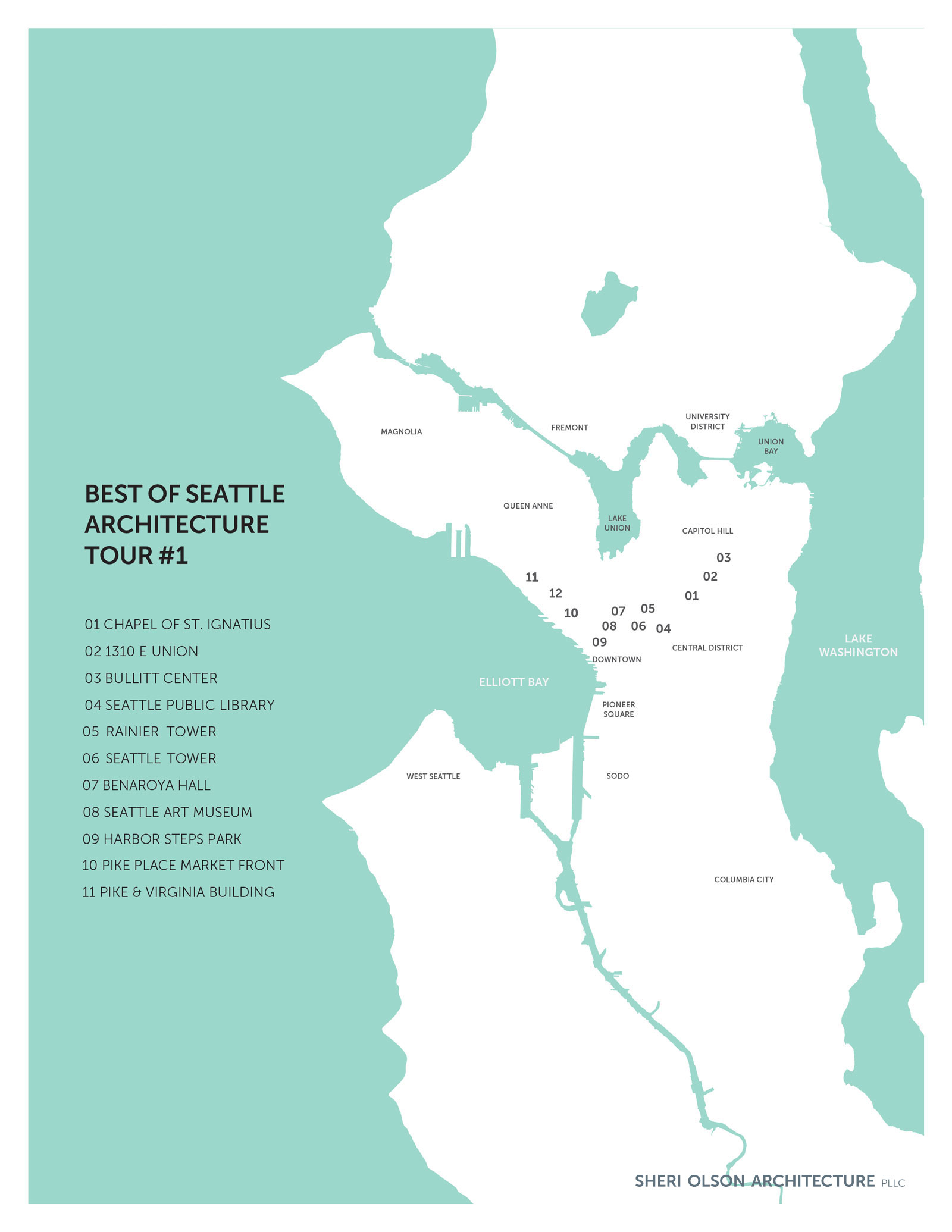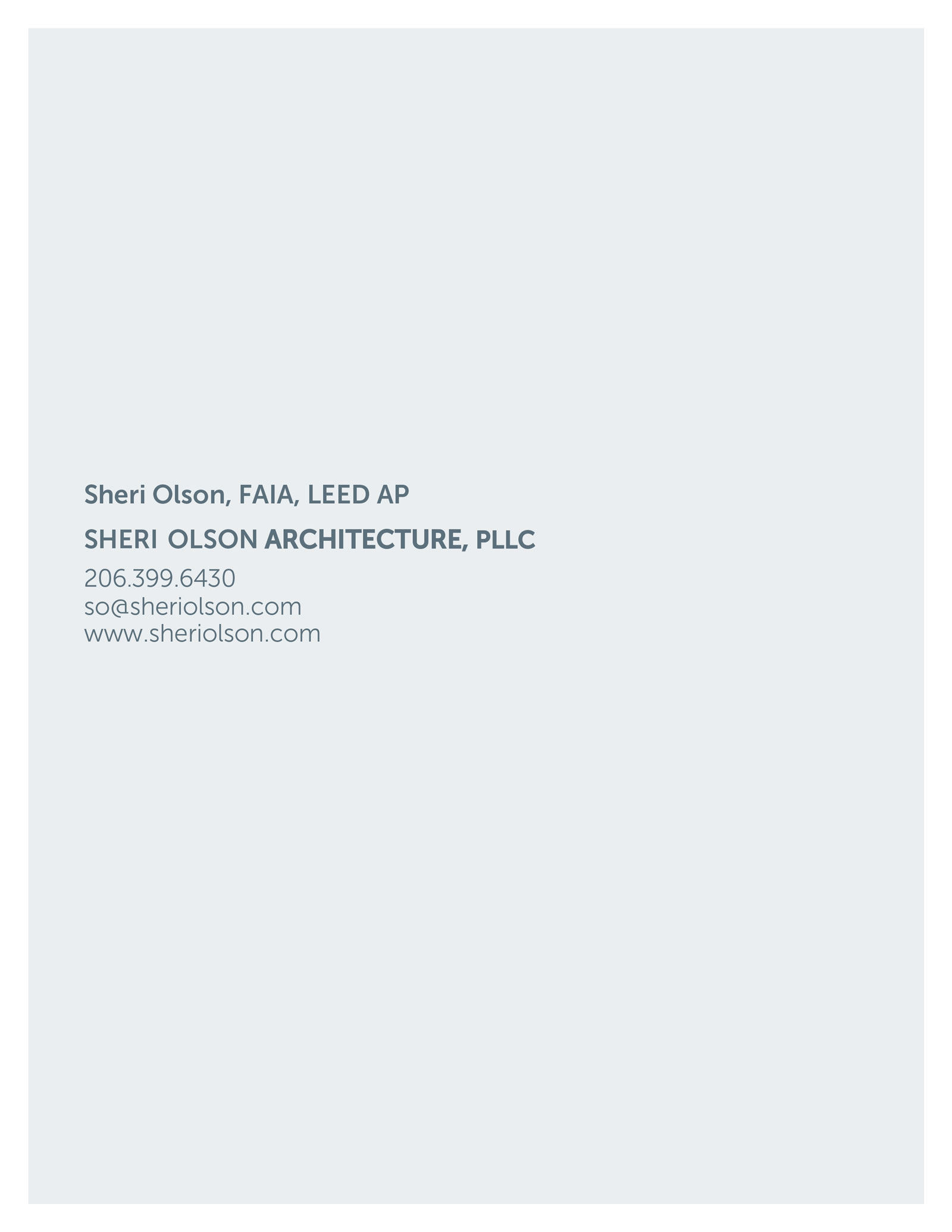Map of the Best of Seattle Architecture

As the architecture critic for the Seattle Post-Intelligencer, I developed a walking tour of significant buildings downtown.
01 | Chapel of St. Ignatius, Seattle University (1997)
Steven Holl | 900 Broadway
Thanks to Seattle University, one of the Top 10 buildings in the United States is in our own backyard. Bremerton-born and now world famous architect Steven Holl translated the Jesuit priests’ religious metaphor of a “light that comes from above” into a dramatic roofscape of light scoops that emerge from an inscrutable concrete box. The exterior walls are oversized slabs of tilt-up concrete that fit together like a jigsaw puzzle with strategically placed fused-glass windows where the panels come together. Inside, Day-Glo colored glass lenses set in the light scoops cast halos of otherworldly color around the sculptural white plaster interior. The chapel rewards repeat visits with constant variations in light as clouds cross the sky and the seasons change
02 | 1310 E Union (2001)
Miller Hull
With over 120 design awards, Miller/Hull is one of the most acclaimed firms in the city, producing consistently fine work, and this may be their best in-city project. Working with a young, first-time developer and retired Microsoft executive, Liz Dunn, they created a loft-style glass-and-steel condominium complex that fills an empty lot in what was at the time a burgeoning Pike/Pine neighborhood. The minimalist modern facade is an exposed steel frame with brick red X bracing in-filled with glass and glazed garage doors that roll up to open whole walls of units. Inside, the spaces are double height and have a raw industrial feel with exposed concrete floors, steel beams and steel deck ceilings.
03 | Bullitt Center (2013)
Miller Hull | 1501 E Madison
The most significant building on this list, the Bullitt Center, is the first net zero office building in the US; it has 100% onsite renewable energy, water and waste management and is designed to last 250 years. The architects started the design by figuring out how much energy could be produced by solar panels on the roof. They then calculated the energy loads of a typical office building and worked backwards to reduce loads. This involved using a ground source geothermal heat exchange system, radiant heat and cooling and an automated external blind system that rolls down to block heat before it enters the building. Thanks to composting foam flush toilets, a 56,000 gallon rainwater cistern and rainwater filtration, the building is 80% more water efficient than a typical Seattle office building. One of the most important factors in getting to net zero was changing the behavior of the human occupants. There is no on-site parking, an “irresistible stair” discourages using the elevator and the indoor temperature varies from the standard 68 degrees. A control panel measures and records the building’s performance to keep it on target.
04 | The Seattle Public Library (2004)
Rem Koolhaas/OMA, LMN | 1000 Fourth Ave
This may have been the golden age for Seattle architecture: hundreds of people showed up at a series of public presentations by international architects vying for the commission. Dutch architect Rem Koolhaas prevailed with his cool delivery and origami model unfolded in front of the audience. The finished project resembles a stack of books, blocks of floors shift out of vertical alignment to adjust to light, views and the site’s steep slope, while a glass skin unifies the multifaceted form and defines the public spaces in between. Inside, the library’s most innovative—and controversial—feature is a spiral of books that allows the nonfiction collection to expand or contract without disrupting Dewey Decimal order.
05 | RainierTower (1977)
Minoru Yamasaki | 1301 Fifth Avenue
After the completion of the (not-well received) World Trade Center In New York City, Yamasaki faced a bitter divide in the architecture profession and the community about his design for this 32-story tower. He balanced the tower on a 12-story windowless pedestal that narrows to a width of 68 feet at the street. When New York critic Paul Goldberger deigned to comment negatively on it (“We may know that the building will not fall down, but that is not enough to make walking past it comfortable.”) Seatteites leapt to its defense.
06 | Seattle Tower (1929)
Albertson, Wilson & Richardson | 1218 Third Ave
The original headquarters for the Northern Life Insurance Company, this is the finest example of an art deco skyscraper in the city. The architects emphasized the tower’s vertical piers to make it look taller than its 27 stories. The rocky slopes of Mt. Rainier inspired its incised step-back form (at one time accentuated by 200 floodlights). The exterior is clad with 33 shades of brick that graduate from dark iron-ore color at the base to a light tan at the top. Inside, the marble lobby has intricate bronze panels and a ceiling depicting the local flora and fauna.
07 | Benaroya Hall (1998)
LMN | 200 University
The location of this project had a large impact on the redevelopment of downtown. Instead of being placed at Seattle Center, a forward-looking group of trustees agreed to locate the new symphony hall downtown at a time when the city center was struggling. Only problem: the site was over an active underground railroad track. The solution was to float the concert hall on rubber pads for sound isolation.
08 | Seattle Art Museum( 1992, 2007)
Venturi Scott Brown, Allied Works | 1300 First Avenue
Seattle went out on a limb hiring an architect’s architect for the new SAM downtown. The post-modern design never got the support here that it deserves and was undercut by a (granted, elegant) addition/renovation by Allied Works. The husband/wife team’s theoretical work opposed the reductive modernism running rampant in cities and argued to bring back the “banality and mess” of popular culture. One sign of this is the giant billboard SEATTLE ART MUSEUM carved into the limestone facade. It’s also a carefully crafted urban experience with a ceremonial stair–both inside and outside–that connects Seattle to the waterfront.
09 | Harbor Steps Park (1994)
Arthur Erickson | 1221 First Avenue
This urban park is Seattle’s version of Rome’s Spanish Steps. Designed by renowned Canadian architect Arthur Erickson, the park connects First and Western Avenues with a series of cascading plazas and waterfalls that extends the University Street corridor from Benaroya Hall and the Seattle Art Museum to the waterfront. The cafes, restaurants, offices, housing and daycare in the towers draw people 24-hours a day, ensuring a lively public place. Trickling water masks traffic sounds and the steep climb is interrupted with enough generous landings to make it an enjoyable ascent.
10 | Pike Place Market – MarketFront (2017)
Miller Hull (2017) | Western Avenue
The first major addition to Pike Place Market in 40 years, the project steps down the hill and will connect to the new waterfront design by James Corner Field Operations to be built when the viaduct is removed. MarketFront adds space for 47 new market stalls, features a Producers Hall with a brewery, restaurant and chocolatier. The project also includes 40 units of low-income, senior housing, the Market Commons– a social services center–and 30,000 SF of open public space.
11 | Pike & Virginia Building (1978)
Olson Walker | 87 Virginia Street
Why aren’t there more buildings like this is in Seattle? This project has sophisticated massing that combines a threestory storefront block along Pike Place Market with a sixstory block of condos behind. The simple concrete frame, either filled with glass of left open for terraces, references the waterfront’s industrial-commercial past while being thoroughly modern.
About SHERI OLSON, FAIA
I’m a registered architect with over 25 years of experience. I have a Masters of Advanced Architectural Design from Columbia University in New York, and a Bachelor of Architecture from the University of Arizona. I am LEED certified in green design. In 2004 I was advanced to the American Institute of Architect’s College of Fellows for my contributions to the profession. As an architectural journalist for 10 years, I spent time with some of the best architects in the world—including Frank Gehry, Steven Holl and Rem Koolhaas—talking one-onone with them about design and exploring their projects. I approach my own design practice with everything I
learned from this enlightening experience. I’m active in many aspects of the design field, including architectural education and community development. I’ve taught design at the Rhode Island School of Design, the University of Texas at Austin and the University of Washington and am a sought after lecturer and public speaker on architecture. Seattle’s mayor appointed me to both the Design Commission and the Design Review Board. I’m on the Board of Architects Without Borders and I’m currently providing pro-bono design services for a new school in Nicaragua.
Have an Upcoming Project?
My firm offers full architectural services from helping clients to determine their needs to being your advocate during construction. I enjoy working with clients who love design and want to be part of a collaborative process.
Email me at contact@sheriolson.com to set up a time to talk about your upcoming project.
Additional Articles
(206) 720-5510 | contact@sheriolson.com





